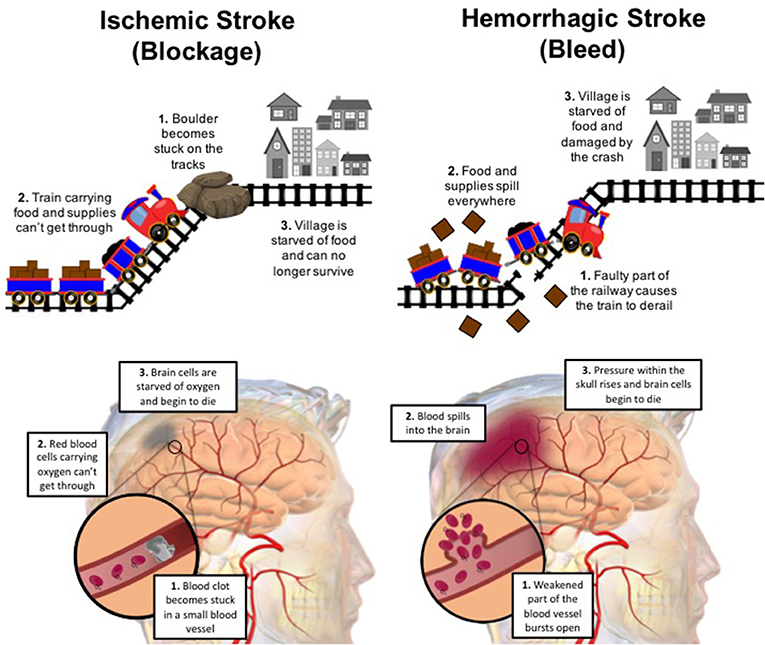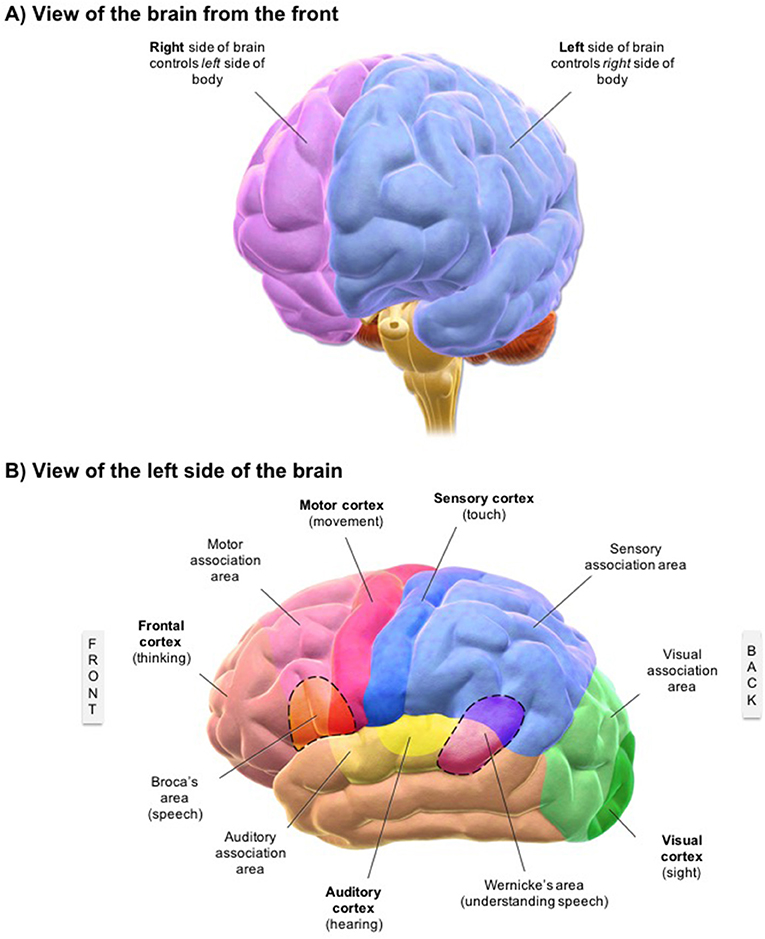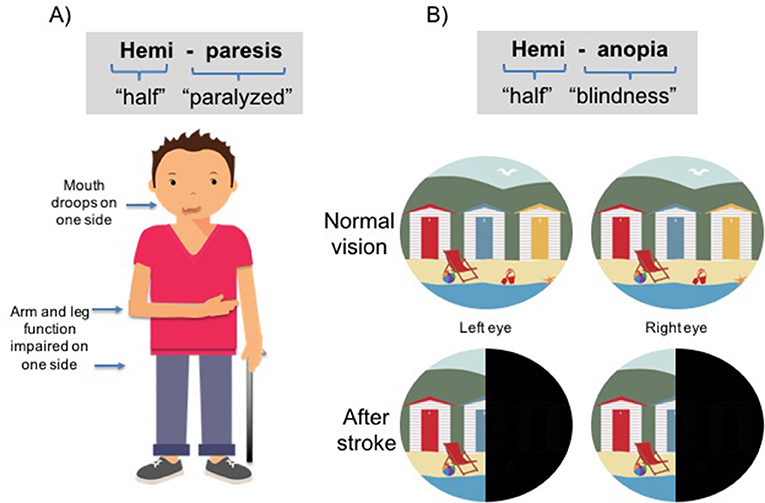what happens after a stroke to the brain
Abstract
Our brains are incredible. They allow us to speak, retrieve, motility, and then much more. The connections in our brains human action equally a circuitous network, more powerful than the best computer ever fabricated. But what happens when a part of that network is damaged? What consequences will this have and how will the encephalon repair and recover? In this article, we explore a mutual brain injury—a stroke. We discuss how a stroke occurs, what impairments are caused by a stroke, and how the encephalon begins to repair and recover as best equally possible. Lastly, we outline five key points that therapists go on in listen when they are helping a patient recover after a stroke.
What Is a Stroke?
A stroke is when an expanse of the brain is starved of oxygen and brain cells in that surface area of the brain brainstorm to die. At that place are two ways this can happen. The most common is through a blockage or a blood clot. This type of stroke is called an "ischemic" (pronounced "iss-skee-mick") stroke. To meliorate understand an ischemic stroke, let us imagine the blood vessels in your brain as a railway, supplying villages and towns with food to proceed the people alive (meet Figure 1 - Left). The trains that run on the railway bear loads of food to exist delivered to the village, just as the blood vessels in the body carry oxygen to be delivered to the brain cells. An ischemic stroke occurs when a blood vessel (or railway) carrying oxygenated claret (food) becomes blocked past a jell (boulder), leaving the encephalon cells (or villages) that rely on oxygen from that blood vessel to slowly starve and die.

- Effigy i - In that location are two means that a stroke can occur.
- The images on the left depict an ischemic stroke. The images on the right depict a hemorrhagic stroke. To better sympathise how a stroke occurs, the top images use a railway supplying food to a village as an analogy for the way blood vessels in the encephalon supply oxygen to the brain cells. Railway, blood vessel; train, cherry-red blood cell; food, oxygen; village, encephalon cells; bedrock, claret clot.
A "hemorrhagic" (pronounced "hem-or-adge-ick") stroke, or brain bleed, is the other type of stroke, and likewise the most life-threatening (see Effigy 1 - Correct). A hemorrhagic stroke occurs when a weak office of a claret vessel ruptures, causing claret to leak into the brain (like a faulty railroad train rail causing the train to derail and crash). As a consequence, areas of the encephalon are starved of oxygen as the leaked blood spills out into other areas of the brain. The leaked blood causes pressure to build up within the skull and brain, causing further damage to the encephalon cells.
What Are the Consequences of a Stroke?
The symptoms of a stroke are varied and depend on which area of the brain is affected. As shown in Effigy two, the brain is organized into singled-out areas that command specific functions. For that reason, when a stroke damages an area of the brain, the patient's symptoms are related to the role that was controlled past that area of the brain. For instance, if the area of the brain that controls arm movement (likewise known equally the motor cortex) is starved of oxygen by a stroke, so y'all would wait to run across issues with the arm, such as weakness or even complete paralysis. Alternatively, if the area of the brain that controls vision (also known every bit the visual cortex) is affected by the stroke, then you would expect the patient to take vision problems.

- Effigy ii - (A) View of the brain from the front.
- Here you can encounter the two sides (or hemispheres) of the brain. (B) The encephalon is organized into areas that control or support specific functions. In this image, tin can you detect the motor cortex? The motor cortex controls motion and is located next to the "motor association area," which assists with planning to movement. Can you detect the visual cortex? The visual cortex controls vision and lets us interpret what nosotros see with our eyes. The auditory cortex controls what we hear, which is side by side to the areas that control how we speak. At that place is too the frontal cortex at the front of the brain, which controls behavior and how we think or brand decisions. Can you notice the surface area that lets us interpret what we feel or affect? This area is called the sensory cortex. Images adapted from Blausen.com [1].
Did you lot know that in that location are two sides to your brain (named the left and right hemispheres, meet Effigy 2A) and that each side of the brain controls the reverse side of the torso? So, if there is damage to the motor expanse on the left side of the brain, so movement on the right side of the torso would be impaired (see Effigy 3A). Or, if the stroke damages the right visual cortex, then a person's ability to see to the left would be impaired (see Effigy 3B).

- Figure iii - Ii common impairments after a stroke are shown.
- In (A), a person with hemiparesis (half paralysis) has problems with his right arm, right leg, and the correct side of his oral fissure. Given that the left side of the brain controls the right side of the body, tin can you tell which side of the brain the stroke occurred on? In (B), the vision of someone with hemianopia (half blindness) is shown. This person has lost the correct half of their vision. Are you able to guess which side of the brain the stroke occurred on? In both cases, the stroke would have been on the left side of the brain, thereby causing impairments on the right side of the body.
What Treatments Are Available Later a Stroke?
First, doctors must determine what kind of stroke has occurred. This is important because each type of stroke requires a dissimilar treatment. Using brain scanning devices, doctors must decide whether a drain or a blockage is causing the patients symptoms.
If a blockage (ischemic stroke) is identified, the goal of treatment is to remove the blood clot. (That is why these treatments are called clot-busters!) Clot-busting medications are given to the patient to break downward and dissolve the clot that is causing the blockage. Alternatively, surgery can be performed and a wire tin be sent up into the blood vessel to pull the clot out.
If a bleed (hemorrhagic stroke) is identified, the goal for treatment is to end the bleeding and reduce pressure building up inside the skull. A bleed is most commonly treated using medications to reduce blood pressure and bleeding in the brain. In some cases, surgery may be required to drill a hole in the skull and release the force per unit area on the brain. Another surgery option is to identify a clasp around the broken office of the blood vessel to clamp it shut and cease the bleeding.
Chiefly, when a person is suspected of having a stroke, doctors must act rapidly to render normal blood catamenia and normal pressure in the brain. The quicker that claret period can return to normal, the improve take chances that more encephalon cells will exist saved.
Recovery Subsequently a Stroke
In the days and weeks afterwards a stroke, many biological processes in the brain begin to happen naturally or "spontaneously." These processes (1) repair neurons and other encephalon cells that were injured simply did not die, and (ii) clean up and remove encephalon cells that are dead.
The next stride in the recovery process requires the brain to restructure and repair the damaged area. This important process is called neuroplasticity . Neuroplasticity is the ability of the brain to change, to learn, and to re-larn. Interestingly, scientists used to believe that neuroplasticity only occurred in babies as their brains developed throughout childhood. Simply now nosotros know that the brain is continually changing throughout our entire lives. Neuroplasticity can occur by irresolute the connections betwixt brain cells in the brain, such as improving the strength of a connexion, increasing or decreasing the number of connections, or irresolute the part of a connection. In some cases, neuroplasticity may as well involve the generation of new neurons (a process known as neurogenesis). However, more research is needed to find out how much neurogenesis contributes to stroke recovery.
V Tips for Enhancing Neuroplasticity and Recovery After Stroke
Neuroplasticity, or the ability of the brain to change, is the key principle that guides how therapists pattern and deliver rehabilitation programs for patients. Typically, the start goal of rehabilitation is to help the patients become back to the way they were before the stroke. Unfortunately this is not always possible, and then for some stroke survivors, the goal of therapy is to detect a new way of doing things.
Below are 5 important tips well-nigh neuroplasticity that therapists must consider when treating a patient (based on the article by Kleim and Jones [2]).
Tip 1—"Employ It or Lose It"
A healthy encephalon maintains connections that are used oftentimes and "cleans abroad" connections that are not used for a period of time. But like a muscle, if you do non use information technology enough the cells will weaken. Based on this rule, therapists encourage patients to keep moving the dumb limb to prevent connections in the brain from beingness lost.
Tip ii—"Use It and Meliorate It"
When you perform a job and practice it over and over over again, the same network of connections in the brain is activated over and over once more. Repeated activation of that network causes information technology to be strengthened and piece of work more efficiently, which ultimately leads to improved operation of the job. For example, when you practice playing an instrument, your performance gets better with practice as the network of connections in your brain that you use to play your instrument is strengthened. Therapists encourage patients to keep practicing their exercises and using their impaired side, as this will lead to positive changes in those specific brain networks.
Tip 3—"Practice Specific"
Rehabilitation exercises should be specific to the task or function that the patient wants to improve. If you want to change the area of the encephalon that controls the arm, yous need to practise doing tasks with the arm. If you lot want to improve office of the left leg, do exercises with the left leg. If the patient is having problems with belongings a fork, then the therapist will requite specific exercises that mimic the position of the hand while it is holding a fork.
Tip 4—"Practice Repeatedly"
To enable the brain to change, many repetitions of a task need to be performed. For case, if you were learning how to juggle, would your ability to juggle be better if y'all skillful 3 times or if you practiced 30 times? The aforementioned is true for therapy after stroke, the more than repetitions the amend! Therapists encourage patients to practice repeatedly and keep practicing their exercises at dwelling. The more repetitions the patient can practice each solar day, the quicker the brain will suit and learn.
Tip v—"Exercise Intensely"
It is also important that when the patient practices, he or she practices intensely. This may be accomplished past doing many repetitions or doing tasks that are challenging. Just like training for a long-distance race, yous might beginning with short distances at commencement, but to become better, you accept to push your muscles to work harder and run longer than you lot did before. This is the same in the encephalon. To encourage the networks in the brain to change, therapists challenge the patient to work harder and achieve a little more than each fourth dimension.
Summary
A stroke occurs when an surface area of the brain is starved of oxygen, caused by a blockage or a drain in the brain. The subsequently-effects of a stroke depend on which expanse of the brain was afflicted. Neuroplasticity is the process that allows the encephalon to recover from a stroke. Therapists design rehabilitation programs based on what is known about neuroplasticity, with the goal of returning the patient back to normal. The five tips explained above are essential principles for stroke rehabilitation.
Glossary
Stroke: ↑ When an area of the brain is damaged from a lack of oxygen. Ischemic stroke is when there is a blockage, whereas hemorrhagic stroke is when there is a drain in the encephalon.
Claret Vessel: ↑ Carries blood throughout the body. At that place are different types of blood vessels, such as arteries, which bear blood full of oxygen to the brain, or veins, which comport claret from the brain to the lungs to be reloaded with oxygen.
Neuron: ↑ Specialized brain prison cell that computes and communicates information through its many connections. Neurons brand connections with other neurons to form networks that control specific functions.
Neuroplasticity: ↑ The power of the brain to adapt and change.
Rehabilitation: ↑ Restoring a person'due south health through training and therapy.
Conflict of Interest Statement
The author declares that the research was conducted in the absenteeism of any commercial or financial relationships that could exist construed as a potential conflict of involvement.
References
[1] ↑ Blausen.com, Due south. 2014. Medical gallery of Blausen Medical 2014. WikiJ. Med. 1. doi: 10.15347/wjm/2014.010
[2] ↑ Kleim, J. A., and Jones, T. A. 2008. Principles of feel-dependent neural plasticity: implications for rehabilitation afterwards brain impairment. J. Speech. Lang. Hear. Res. 51:S225–39. doi: 10.1044/1092-4388(2008/018)
mooreorlintands1970.blogspot.com
Source: https://www.frontiersin.org/articles/413351
0 Response to "what happens after a stroke to the brain"
Post a Comment